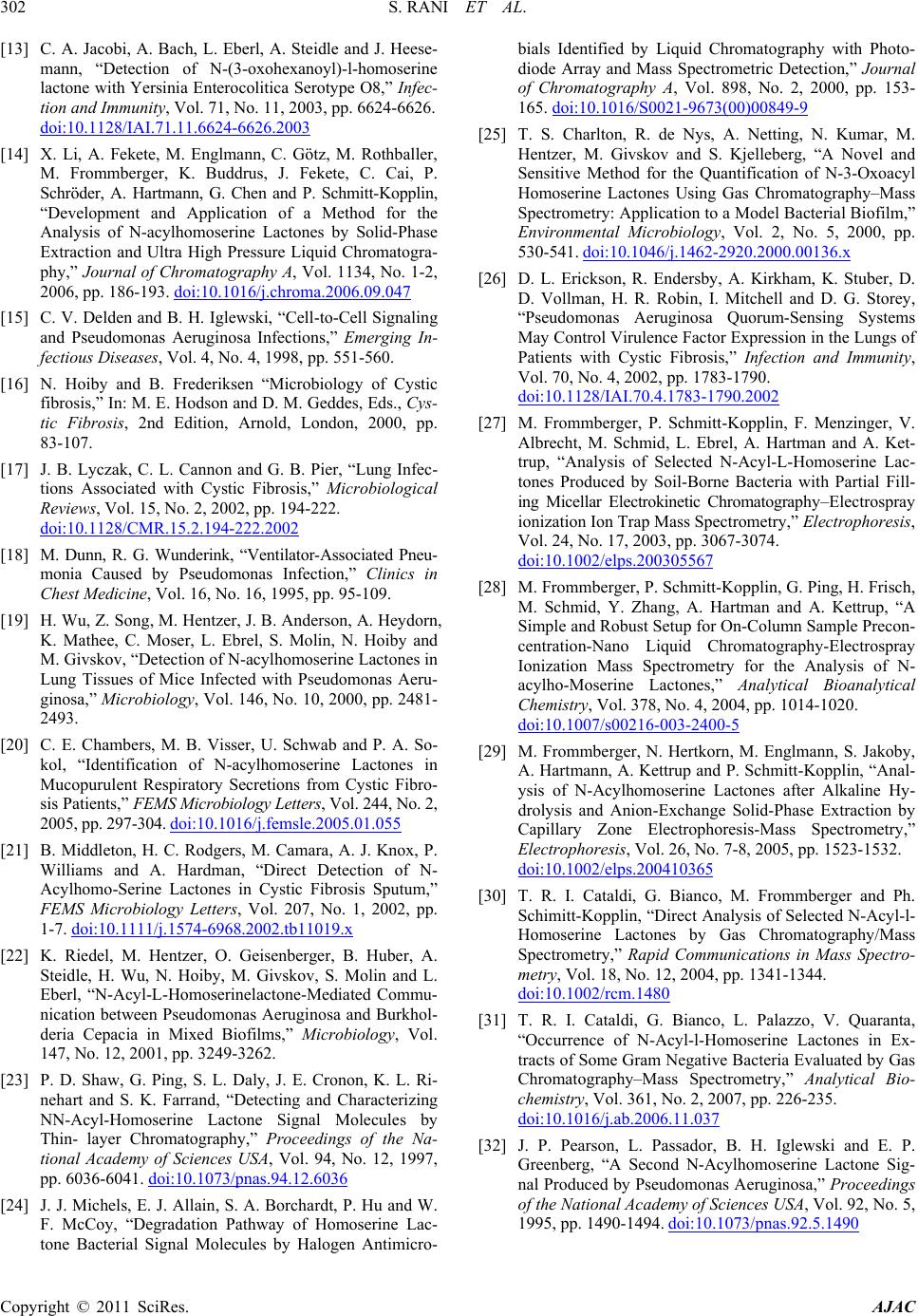
S. RANI ET AL.
Copyright © 2011 SciRes. AJAC
[13] C. A. Jacobi, A. Bach, L. Eberl, A. Steidle and J. Heese-
mann, “Detection of N-(3-oxohexanoyl)-l-homoserine
lactone with Yersinia Enterocolitica Serotype O8,” Infec-
tion and Immunity, Vol. 71, No. 11, 2003, pp. 6624-6626.
doi:10.1128/IAI.71.11.6624-6626.2003
[14] X. Li, A. Fekete, M. Englmann, C. Götz, M. Rothballer,
M. Frommberger, K. Buddrus, J. Fekete, C. Cai, P.
Schröder, A. Hartmann, G. Chen and P. Schmitt-Koppli n,
“Development and Application of a Method for the
Analysis of N-acylhomoserine Lactones by Solid-Phase
Extraction and Ultra High Pressure Liquid Chromatogra-
phy,” Journal of Chromatography A, Vol. 1134, No. 1-2,
2006, pp. 186-193. doi:10.1016/j.chroma.2006.09.047
[15] C. V. Delden and B. H. Iglewski, “Cell-to-Cell Signaling
and Pseudomonas Aeruginosa Infections,” Emerging In-
fectious Dise ases, Vol. 4, No. 4, 1998, pp. 551-560.
[16] N. Hoiby and B. Frederiksen “Microbiology of Cystic
fibrosis,” In: M. E. Hodson and D. M. Geddes, Eds., Cys-
tic Fibrosis, 2nd Edition, Arnold, London, 2000, pp.
83-107.
[17] J. B. Lyczak, C. L. Cannon and G. B. Pier, “Lun g Infec-
tions Associated with Cystic Fibrosis,” Microbiological
Reviews, Vol. 15, No. 2, 2002, pp. 194-222.
doi:10.1128/CMR.15.2.194-222.2002
[18] M. Dunn, R. G. Wunderink, “Ventilator-Associated Pneu-
monia Caused by Pseudomonas Infection,” Clinics in
Chest Medicine, Vol. 16, No. 16, 1995, pp. 95-109.
[19] H. Wu, Z. Song, M. Hentzer, J. B. Anderson, A. Heydorn,
K. Mathee, C. Moser, L. Ebrel, S. Molin, N. Hoiby and
M. Givskov, “Detection of N-acylhomoserine Lactones in
Lung Tissues of Mice Infected with Pseudomonas Aeru-
ginosa,” Microbiology, Vol. 146, No. 10, 2000, pp. 2481-
2493.
[20] C. E. Chambers, M. B. Visser, U. Schwab and P. A. So-
kol, “Identification of N-acylhomoserine Lactones in
Mucopurulent Re spiratory Secretions from Cystic Fibro-
sis Patients,” FEMS Microbiology Letters, Vol. 244, No. 2,
2005, pp. 297-304. doi:10.1016/j.femsle.2005.01.055
[21] B. Middleton, H. C. Rodgers, M. Camara, A. J. Knox, P.
Williams and A. Hardman, “Direct Detection of N-
Acylhom o -Serine La ctones in Cystic Fibrosis Sputum,”
FEMS Microbiology Letters, Vol. 207, No. 1, 2002, pp.
1-7. doi:10.1111/j.1574-6968.2002.tb11019.x
[22] K. Riedel, M. Hentzer, O. Geisenberger, B. Huber, A.
Steidle, H. Wu, N. Hoiby, M. Givskov, S. Molin and L.
Eberl, “N-Acyl-L-Homoserinelactone-Mediated Commu-
nication between Pseudomonas Aeruginosa and Burkhol-
deria Cepacia in Mixed Biofilms,” Microbiology, Vol.
147, No. 12, 2001, pp. 3249-3262.
[23] P. D. Shaw, G. Ping, S. L. Daly, J. E. Cronon, K. L. Ri-
nehart and S. K. Farrand, “Detecting and Characterizing
NN-Acyl-Homoserine Lactone Signal Molecules by
Thin- layer Chromatography,” Proceedings of the Na-
tional Academy of Sciences USA, Vol. 94, No. 12, 1997,
pp. 6036-6041. doi:10.1073/pnas.94.12.6036
[24] J. J. Michels, E. J. Allain, S. A. Borc hardt, P. Hu and W.
F. McCoy, “Degradation Pathway of Homoserine Lac-
tone Bacterial Signal Molecules by Halogen Antimicro-
bials Identified by Liquid Chromatography with Photo-
diode Array and Mass Spectrometric Detection,” Journal
of Chromatography A, Vol. 898, No. 2, 2000, pp. 153-
165. doi:10.1016/S0021-9673(00)00849-9
[25] T. S. Charlton, R. de Nys, A. Netting, N. Kumar, M.
Hentzer, M. Givskov and S. Kjelleberg, “A Novel and
Sensitive Method for the Quantification of N-3-Oxoacyl
Homoserine Lactones Using Gas Chromatography–Mass
Spectrometry: Application to a Model Bacterial Biofilm,”
Environmental Microbiology, Vol. 2, No. 5, 2000, pp.
530-541. doi:10.1046/j.1462-2920.2000.00136.x
[26] D. L. Erickson, R. Endersby, A. Kirkham, K. Stuber, D.
D. Vollman, H. R. Robin, I. Mitchell and D. G. Storey,
“Pseudomonas Aeruginosa Quorum-Sensing Systems
May Control Virulence Factor Expression in the Lungs of
Patients with Cystic Fibrosis,” Infection and Immunity,
Vol. 70, No. 4, 2002, pp. 1783-1790.
doi:10.1128/IAI.70.4.1783-1790.2002
[27] M. Frommberger, P. Schmitt-Kopplin, F. Menzinger, V.
Albrecht, M. Schmid, L. Ebrel, A. Hartman and A. Ket-
trup, “Analysis of Selected N-Acyl-L-Homoserine Lac-
tones Produced by Soil-Borne Bacteria with Partial Fill-
ing Mice llar Electrokinetic Chromatography–Elec trospray
ionization Ion Trap Mass Spectrometry,” Electrophoresis,
Vol. 24, No. 17, 2003, pp. 3067-3074.
doi:10.1002/elps.200305567
[28] M. Frommberger, P. Schmitt-Kopplin, G. Ping, H. Frisch,
M. Schmid, Y. Zhang, A. Hartman and A. Kettrup, “A
Simple and Robust Setup for On-Column Sample Precon-
centration-Nano Liquid Chromatography-Elect rospray
Ionization Mass Spectrometry for the Analysis of N-
acylho -Mos erine Lactones,” Analytical Bioanalytical
Chemistry, Vol. 378, No. 4, 2004, pp. 1014-1020.
doi:10.1007/s00216-003-2400-5
[29] M. Frommberger, N. Hertkorn, M. Englmann, S. Jakoby,
A. Hartmann, A. Kettrup and P. Schmitt-Kopplin, “Anal-
ysis of N-Acylhomoserine Lactones after Alkaline Hy-
drolysis and Anion-Exchange Solid-Phase Extraction by
Capillary Zone Electrophoresis-Mass Spectrometry,”
Electrophoresis, Vol. 26, No. 7-8, 2005, pp. 1523-1532.
doi:10.1002/elps.200410365
[30] T. R. I. Cataldi, G. Bianco, M. Frommberger and Ph.
Schimitt-Kopplin, “Direct Analysis of Selected N-Acyl-l-
Homoserine Lactones by Gas Chromatography/Mass
Spectrometry, ” Rapid Communications in Mass Spectro-
metry, Vol. 18, No. 12, 2004, pp. 1341-1344.
doi:10.1002/rcm.1480
[31] T. R. I. Cataldi, G. Bianco, L. Palazzo, V. Quaranta,
“Occurrence of N-Acyl-l-Homoserine Lac tones in Ex-
tracts of Some Gram Negative Bacteria Evaluated by Gas
Chromatography–Mass Spectrometry,” Analytical Bio-
chemistry, Vol. 361, No. 2, 2007, pp. 226-235.
doi:10.1016/j.ab.2006.11.037
[32] J. P. Pearson, L. Passador, B. H. Iglewski and E. P.
Greenberg, “A Second N-Acy lhomoserine Lactone Sig-
nal Produc ed by Pseudomonas A eruginosa,” Proceedings
of the National Academy of Sciences USA, Vol. 92, No. 5,
1995, pp. 1490-1494. doi:10.1073/pnas.92.5.1490